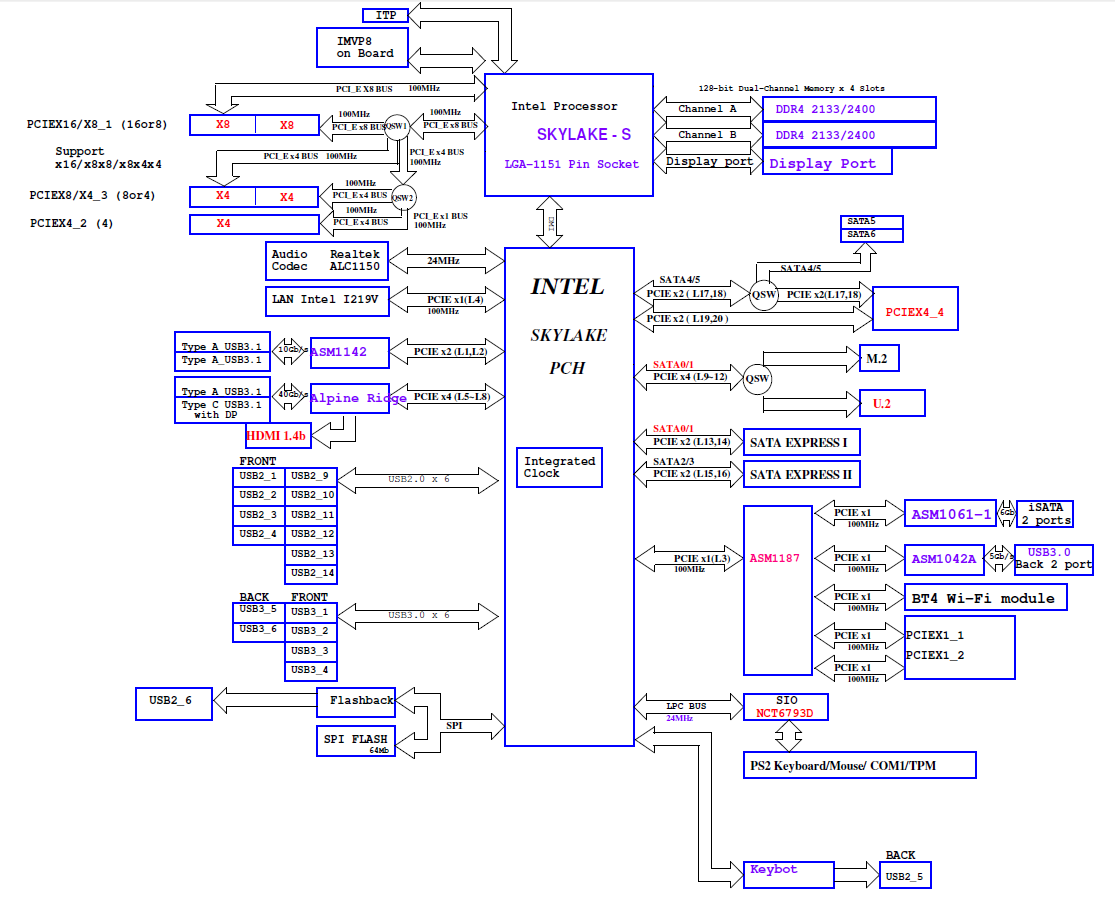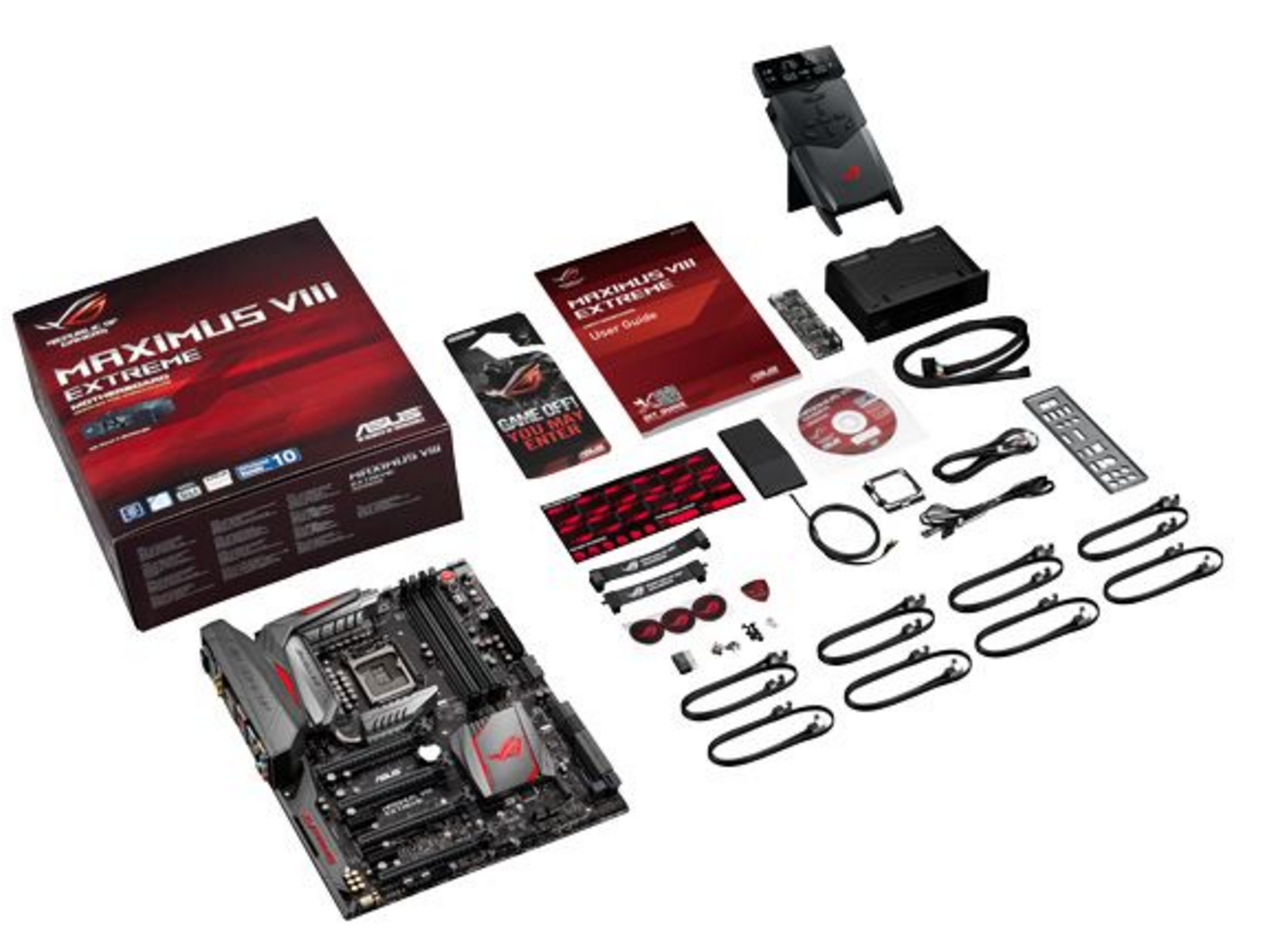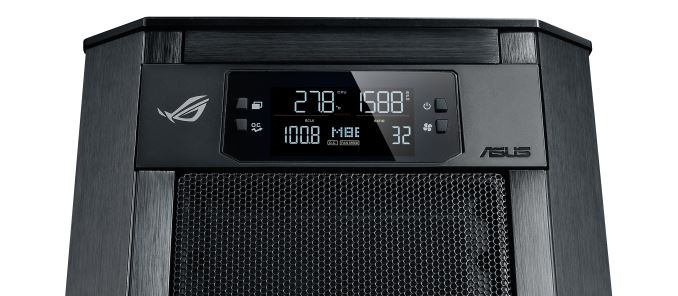The ASUS Maximus VIII Extreme Review: The Other $500 Option
by Ian Cutress on April 7, 2016 9:00 AM EST- Posted in
- Motherboards
- Gaming
- Asus
- ROG
- Skylake
- Z170
- Thunderbolt 3
Board Features
Having gone through and generated the following table for the M8E, I find it mildly amusing, especially as I’ve just put a $120 motherboard on the test bed here. By comparison, instead of most of the sections saying none/blank, when dealing with a $500 motherboard everything is filled up. More SATA ports, more features and more room to add things means that a halo motherboard has to be the Rambo of a PC build.
| ASUS Maximus VIII Extreme | |
| Warranty Period | 3 Years |
| Product Page | Link |
| Price | Amazon US |
| Size | E-ATX |
| CPU Interface | LGA1151 |
| Chipset | Intel Z170 |
| Memory Slots (DDR4) | Four DDR4 Supporting 64GB Dual Channel Up to 3866 MHz |
| Memory Slots (DDR3L) | None |
| Video Outputs | HDMI to 4096x2160 @ 24 Hz DisplayPort at 4096x2304 @ 60 Hz |
| Network Connectivity | Intel I219-V 3T3R 802.11ac Wi-Fi Go! Module |
| Onboard Audio | Realtek ALC1150 with ESS ES9023P DAC bypass |
| PCIe Slots for Graphics (from CPU) | 3 x PCIe 3.0 (x16, x8/x8, x8/x4/x4) |
| PCIe Slots for Other (from PCH) | 1 x PCIe 3.0 x4 2 x PCIe 3.0 x1 |
| Onboard SATA | Six, RAID 0/1/5/10 Two from ASMedia ASM1061 |
| Onboard SATA Express | Two, RAID |
| Onboard M.2 | 1 x PCIe 3.0 x4 or SATA, RAID 0/1, NVMe |
| Onboard U.2 | 1 x PCIe 3.0 x4 (switched with M.2) |
| Thunderbolt | TB3 via Type-C |
| USB 3.1 | 2 x Type-A from ASMedia ASM1142 Controller 1 x Type-A and 1 x Type-C from Intel Alpine Ridge |
| USB 3.0 | 4 x Rear Panel 4 via headers |
| USB 2.0 | 6 via headers |
| Power Connectors | 1 x 24-pin ATX 1 x 8-pin CPU 1 x 4-pin CPU |
| Fan Headers | 1 x CPU (4-pin) 1 x CPU_OPT (4-pin) 4 x CHA/SYS (4-pin) |
| IO Panel | 1 x Combination PS/2 4 x USB 3.0 3 x USB 3.1 Type-A 1 x USB 3.1 Type-C 1 x Network RJ-45 (Intel I219-V) HDMI DisplayPort Clear CMOS Button USB BIOS Flashback Button 3T3R 802.11ac Wi-Fi Go! Module Audio Jacks |
| Other Features | OC Panel Header Thunderbolt Header 4-pin EZ-PLUG Header Front Panel Header 5-pin Fan Extension Header MemOK! Button Slow Mode Switch 9 x Voltage measurement points 3 x Thermal Sensor Headers 1 x DRAM Channel Jumper Power/Reset Buttons BIOS Switch Button SLI/CFX Switch LN2 Mode Jumper Safe Boot Button ReTry Button |
The big active features for ASUS come in at the 3T3R tri-stream WiFi, an ESS DAC, Thunderbolt 3 support via Intel’s Alpine Ridge controller, a total of four USB 3.1 ports split between the Alpine Ridge and ASMedia’s ASM1142 controller and then the sheer amount of switches and buttons onboard for power users to configure their experience. The OC Panel header for both power users and extreme overclockers comes in handy with the bundled OC Panel.
Using the chipset diagram, it shows a slightly more complex picture. Everything on the left side is what we would expect, including the complex way that x8/x4/x4 is implemented on the PCIe side, although it is worth noting that the HDMI 1.4b port is provided through the Alpine Ridge controller rather than the CPU. I would assume this is actually just a bypass to help with routing though it may suggest that the TB3 controller cannot use HDMI when the DisplayPort functionality is in use. I’ll be synchronizing with ASUS on this.
On the right hand side we see that two of the SATA ports (4/5) share bandwidth with the PCIe x4 slot at the bottom of the board. When SATA devices are connected, the PCIe slot will reduce to x2 bandwidth. Also on the right hand side is an ASM1187 controller, which looks like a 6-port PCIe switch. Taking one PCIe lane in, it gives an output to five ports which include the two ASMedia SATA ports, two of the rear USB 3.0 ports, the Wi-Fi module and the two PCIe x1 slots. However, unless one of the PCIe x1 slots is using full bandwidth, I doubt it is much of an issue, and if anything it would be a latency issue. But it might also explain why we could not get proper USB 3.0 speed results through the ASMedia controller.
In The Box
We get the following:
User Manual
Driver DVD
Rear IO Shield
OC Panel plus 5.25-inch Bay
Fan Extension Board
Wi-Fi Antenna
Thermal Probes
CPU Installation tool
Eight SATA Cables
Q-Connectors
ASUS ROG Stickers
ASUS ROG Door Handle Sign
Flexi-CrossFire Connector
Flexi-SLI Connector
At $500 and being part of the ROG brand it means the in-box goodies should be plentiful. The star of the pack is the OC Panel, used by extreme overclockers to make adjustments on the fly or system builders to monitor fan speeds/temperatures with one-button overclocks.
We’ve discussed the OC Panel at length before, and this is the third generation with the same model, featuring more fan headers, VGA Hotplug and extra switches for system control.
Also in the box are a set of thermal probes to use on the extra thermal probe headers on the motherboard, giving the ASUS software extra read points for temperature if the user wants to monitor specific zones in their build. The CPU installation tool is there to help new build users put the processor in the motherboard, although I didn’t find much use for it (I’ve never dropped a CPU in a socket yet…). It is interesting to see so many SATA cables in the box though, however these are mostly likely bought in bulk and minimal cost to a board like this.
ASUS also sells the Maximus VIII Extreme/Assembly, which comes with a custom audio output dock as well as a Tahuti Networks based 10 gigabit Ethernet card using RJ-45.













70 Comments
View All Comments
Flunk - Thursday, April 7, 2016 - link
At that price point you really should be considering an X99-platform system. You're scraping the bottom of the barrel when it comes to diminishing returns.xthetenth - Thursday, April 7, 2016 - link
This board does make sense for people who need a set of high end features that precludes any other boards, but that's few and far between.dsumanik - Friday, April 8, 2016 - link
Lot of talking up the gigabyte 4 way SLI, which was never even tested... As a reviewer wouldn't you wonder if it even works? Curious about the performance? Isn't that the whole reason for this website? To see how the latest and greatest tech performs? Anyways 500 bucks. Nah.jameskatt - Saturday, May 14, 2016 - link
That is the whole point. ASUS makes this motherboard for the few and far between.Ubercake - Thursday, April 7, 2016 - link
I was thinking that same thing. Why are motherboards going up so much in cost when the Processors have taken over most if not all of what used to be the Northbridge functions?If anything the motherboards should be worth less than they were before because for the most part, they aren't providing as much functionality. Granted, some have better voltage control and over-clocking capability, but that shouldn't add much to the cost comparatively. And this isn't the enthusiast lineup either. Not sure what these companies expect.
willis936 - Thursday, April 7, 2016 - link
You don't want to see the BOM of a $500 non server board.jasonelmore - Thursday, April 7, 2016 - link
your paying for the software on most of this high dollar hardware stuff. i know you are probably no interested in that stuff, but asus see's it differently. their magins will always be more than Asrock, so they have to differentiate somehow.Medical equipment is notoriously overpriced for what it is, but it uses custom software that nobody else makes, so they can get away with jacking up the price 2000% over the bill of materials.
close - Friday, April 8, 2016 - link
Medical business is a different animal. The standards and certifications they have to meet/pass means even the basic functions must be implemented in a different (more expensive) way. Things that are acceptable on a consumer product might be totally unacceptable on a medical one where a BSOD might actually involve a death ;).The NB functions were integrated into the CPU but then again motherboards didn't always have 2 NICs, WiFi, tricked up audio, bundled OC panels, etc. And don't forget about the 80/20 rule. You get 80% or results with 20% of the cost but then hang on to your sit because the cherry on top comes at a price. Optimizing the board layout and traces costs and if you want it you'll have to dish out the $500. It's always been the same, the closer you get to the top the quicker the costs pile up.
I for one would never buy ROG again. Half of the stuff it offers is just wasted on me and I considered most features to be overkill and wasteful. I realized that after I started using (or not using) them. But then again there's always a market for this so why not? :)
jameskatt - Saturday, May 14, 2016 - link
If you want the best quality product, then you will pay for it. That is true of any product. The best ones generally take more work to create. It is not simply the cost of the goods to create it. The labor costs can be very high. If you are satisfied with lower quality, then so be it. But there are some who simply want the best and are willing to pay for it. A $500 motherboard is nothing compared to the $25,000+ cost of a high end PC which may include a $2000 CPU, $1200 GPU, $1000 SSD, $8000 data storage system, $5000 professional monitor, etc.chlamchowder - Thursday, April 7, 2016 - link
The processors that work with Z170 have a newer architecture and better performance per-core, while X99 can support processors with more cores (and tons of memory), but generally less per-core performance.It depends on what you need. Gaming, for example, still has trouble scaling even to four cores and can benefit quite a bit from more per-core performance. That said, spending $500 on a motherboard (X99 or Z170) is something I'll never understand.